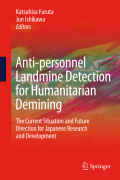
Anti-personnel landmine detection for humanitarian demining: the current situation and future directions for japanese research and development
Furuta, K.
Ishikawa, J.
The conventional method of landmine detection is using metal detectors to sense the metal in mines, but often other metal fragments in minefields camouflage landmines and hinder progress of demining. The challenge is to develop detection systems that can discriminate between AP landmines and random metal fragments. The JST adopted 12 research proposals and the results are reported here.This book concentrates on aspects of three approaches to AP mine detection: enhancing and confirming the results of metal-detection scans using GPR; using robot vehicles and manipulators to operate within minefields remotely; and methods of sensing the explosives within mines. Results are presented in the fields of GPR, nuclear quadruple resonance, neutron thermal analysis and biosensors. The integration of these methods for workable robot operation is demonstrated. The project was carried out in conjunction with mine action centers in Croatia, Cambodia and Afghanistan. Evaluation data from field trials are also given. Will protect people from harm by helping to make the disposal of dangerousordnance quicker and safer Presents state-of-the-art Japanese research in robotics and remote sensing from a co-ordinated consortium of academic and industrial sources INDICE: Introduction: Anti-personnel Landmine Problem and Existing Demining Technologies and Operating Procedures; Japanese Action for Humanitarian Demining.- Dual Sensor Systems: Ground Penetrating Radar and Metal Detectors.
- ISBN: 978-1-84882-345-7
- Editorial: Springer
- Encuadernacion: Cartoné
- Páginas: 235
- Fecha Publicación: 01/03/2009
- Nº Volúmenes: 1
- Idioma: Inglés
